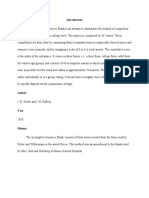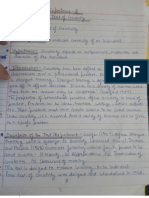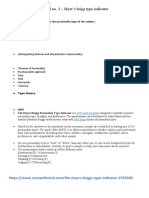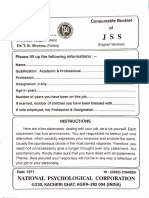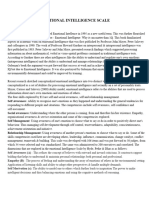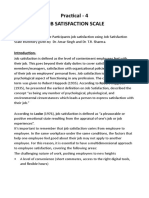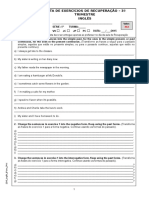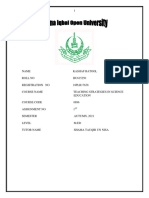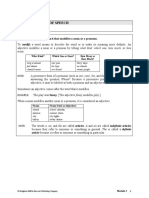Conditions Influencing Counselling
Conditions Influencing Counselling
Uploaded by
singhsanyaCopyright:
Available Formats
Conditions Influencing Counselling
Conditions Influencing Counselling
Uploaded by
singhsanyaCopyright
Available Formats
Share this document
Did you find this document useful?
Is this content inappropriate?
Copyright:
Available Formats
Conditions Influencing Counselling
Conditions Influencing Counselling
Uploaded by
singhsanyaCopyright:
Available Formats
Add to Favourites
Contact us
1.
Counseling Process Factors Influencing the Counseling Process In counseling process we will discuss factors affecting the counseling process. In addition to that, we will study about the first interview, middle phase (working in a counseling relationship) and finally the last interviews or termination of counseling process. The counseling process is influenced by several characteristics that help it become a productive time for the client and counselor. Not all characteristics apply to all situations, but generally, the following help bring about positive results. The process of counseling develops in definable stages with recognizable transitions. The first stage involves building a relationship. It focuses on engaging clients to explore issues that directly affect them. Two struggles take place at that time: 1. Battle for structure, which involves issues of administrative control, by counselor (scheduling, fees, and participation in sessions) 2. Battle for initiative which concerns motivation for change and client responsibility. It is important that the counselor wins the first battle and the client wins the second. Let's discuss all of the important factors influencing counseling process: Structure Initiative Setting Client Qualities Counselor Qualities 1. Structure It refers to the "joint understanding between the counselor & client regarding the characteristics, conditions, procedures, and parameters of counseling" (Day & Sparacio, 1980, p.246). o Structure helps clarify the counselor-client relationship. This give form to what the formal process will look like. Many clients come to counseling with no idea what to expect. Counseling moves forward when client and counselor know the boundaries of the relationship and what is expected. o Structure protects the rights, roles, and obligations of both client and counselor. o Practical guidelines are part of building structure. They include time limits, action limits, procedural limits, specific goals and needs, fee, audio- or video-recording, permission to record, etc. this is therapeutic in itself. o Structure is more important when a client has unrealistic expectation. o Structure is especially important in the beginning but is provided throughout all stages. o To help client new directions to their life, constructive guidelines are provided as clients are in a static state. o The counselor needs to stay flexible and continually negotiate the nature of the structure with their clients. A sample client-counselor contract, provided by Witmer & Remley from University of Florida, is given below to enhance students' understanding: Example: Counselor-Client Contract: (Witmer & Remley, 1994)
Introduction: Our profession is becoming more attuned to client rights as well as to counselor accountability. Both give their addresses here. Please feel free to change the contract...... Qualification/ Experience Nature of counseling (the emphasis is on the professional relationship) Referrals Fee cancellation & insurance Records & confidentiality Signatures 2. Initiative, Reluctance & Resistance Initiative can be thought of as the motivation that the client brings into the session. Majority of the client are reluctant to some degrees. However, Reluctance is generally seen in those clients who are referred for help by a third party and are unmotivated, e.g., school children, and court-referred clients. In such a situation, some counselors become impatient, irritated and insensitive, and may ultimately give up. Counselor needs to understand the dynamics involved in working with difficult clients. Resistance is unwillingness to change. Resistant clients bring a motivation to cling to their issues through various sorts of actions like those with "I don't know" statement. Resistant clients want to cling to the certainty of present and do not want to face the pain that change demands. Four broad categories of resistant clients (Otani, 1988): Otani has pointed out 22 forms of resistance which can be categorized into 4, as described below: Amount of verbalization: shown by silence and minimum talk. Content of message: intellectual talk, emotional display, future/past preoccupation, symptom preoccupation, etc. Style of communication: false promising, thought editing, last-minute disclosure, externalization, thought editing, false promising, etc. Attitude toward counselor and counseling session: poor appointment keeping, payment delays, favor asking, etc. Ways to let client win the battle for initiative: To anticipate the anger and defensiveness To show acceptance and understanding To use persuasion Through confrontation; client can respond by: o Denial o Accepting confrontation as true o Developing a middle position. Using pragmatic techniques: Roloff and Miller have mentioned two pragmatic persuasion techniques: door in the face, and foot in the door. Other pragmatic techniques could be silence, reflection, questioning, sharing, etc. 3. Physical Setting Counseling can happen anywhere, but a professional counselor generally prefers to work in a place that provides privacy, confidentiality, and quietness.
There is no universal quality that a room should have "except it should not be overwhelming, noisy, or distracting" (Benjamin, 1987, p. 3). Room should facilitate rather than distracting the client. In this reference, Shertzer & Stone (1980) indicated that the room should be comfortable and attractive. Features of a counseling room: o Soft lighting o Quiet colors o An absence of clutter o Harmonious and comfortable furniture o The spatial features of the environment; Optimum distance: A distance of 30-39 inch between counselor and client has been found to be the average range of comfort. Desk: Pietrofesa et al. (1984) note the symbolic and physical barrier of a large desk. Auditory and visual privacy is mandatory for maximum client-disclosure. 4. Physical Arrangement Different layouts of the therapy office Cultural and gender preferences may exist, but individual differences are the most important variation to observe. Positioning is expressed by the clinician in the layout of the therapy office. o a large desk is positioned between client and clinician o a small desk is positioned between client and clinician o the clients and clinicians chairs are directly across from each other without obstacles in between Arrangement of chairs should be arranged in relation to each other o face-to-face arrangements o side-by-side seating A therapy office that is set up so that a desk is positioned between client and clinician will communicate something very different from a therapy room in which the clients and clinicians chairs are directly across from each other without obstacles in between. Similarly, the decision about how a client's and counselor's chairs should be arranged in relation to each other communicates different things to different clients. For some, face-to-face arrangements may suggest an attempt at emotional sharing; for others, only side-by-side seating may be acceptable. Benjamin (1987) suggests two chairs and a nearby table. Observation about how clients react to the layout may be helpful in making necessary revisions 5. Client Qualities Clients come in all shapes and sizes, personality characteristics, and degrees of attractiveness (Warnath, 1977). Counselors' interaction is influenced by the physical characteristics of the client (Goldstein, 1973) The most successful clients tend to be YAVIS (Young, attractive, verbal, intelligent, successful) compared to HOUNDs (homely, old, unintelligent, nonverbal, and disadvantaged), or DUDs (dumb, unintelligent and disadvantaged). These observations show that ironically disability and age provide invisible but powerful barriers. Total liking is determined by verbal, vocal, and facial liking. However, in a study nonverbal behavior was shown to be more important (Facial expressions = 55%) than either vocal (38%) or verbal (7%) cues (Mehrabian et al., 1971). Counselors generally like to work with clients who are most lik
You might also like
- Paper 6 - Unit 3 Family Guidance (For Parents of Children With Disabilities)Document10 pagesPaper 6 - Unit 3 Family Guidance (For Parents of Children With Disabilities)Tanvi ManjrekarNo ratings yet
- Ch-5 Therapeutic Approaches - PPT 3Document14 pagesCh-5 Therapeutic Approaches - PPT 3sayooj tv0% (1)
- MPCE 024-2nd Yr En.2101329657 - Sekhar ViswabDocument34 pagesMPCE 024-2nd Yr En.2101329657 - Sekhar ViswabSekhar Viswab100% (1)
- ETHICAL ISSUES IN COUNSELING - SaidaDocument17 pagesETHICAL ISSUES IN COUNSELING - Saidasaidahsalim75% (4)
- Norms and UsesDocument4 pagesNorms and UsesDevshree DantaleNo ratings yet
- Ethical and Social Considerations in TestingDocument21 pagesEthical and Social Considerations in Testingsatori-chan63% (8)
- Personal Qualities of Effective CounselorDocument4 pagesPersonal Qualities of Effective CounselorShaheena HossainNo ratings yet
- Interview Types and Procedure in CounsellingDocument5 pagesInterview Types and Procedure in CounsellingAnto100% (2)
- 10 Qualities of An Effective Clinical PsychologistDocument6 pages10 Qualities of An Effective Clinical PsychologistShareena M R. Epres100% (2)
- Tutorial On Helmholtz MachineDocument26 pagesTutorial On Helmholtz MachineNon SenseNo ratings yet
- Steps Involved in Preparation For CounsellingDocument7 pagesSteps Involved in Preparation For CounsellingAstro Counselor Karan100% (3)
- Nature and Purpose of Clinical Assessment - UNIT 2Document13 pagesNature and Purpose of Clinical Assessment - UNIT 2Brinda ChughNo ratings yet
- Notes On Introduction To Psychological AssessmentDocument14 pagesNotes On Introduction To Psychological AssessmentAstra StarlightNo ratings yet
- Areas of CounsellingDocument19 pagesAreas of CounsellingMuhammad Ahmad NaeemNo ratings yet
- Covert Assertion, SensitizationDocument5 pagesCovert Assertion, SensitizationFatima Malik100% (3)
- Interviewing SkillsDocument6 pagesInterviewing SkillsMuqaddas naz 6026No ratings yet
- C.I.S. Scoring and InterpretationDocument5 pagesC.I.S. Scoring and InterpretationSanjana Satish100% (1)
- Current Research Trends in Positive PsychologyDocument4 pagesCurrent Research Trends in Positive Psychologyabisha.angeline22No ratings yet
- Unit 3 Skill TrainingDocument10 pagesUnit 3 Skill TrainingTanvi Manjrekar100% (1)
- Qualities of A Clinical PsychologistDocument8 pagesQualities of A Clinical Psychologistpsy22No ratings yet
- Introduction To Clinical AssessmentDocument7 pagesIntroduction To Clinical AssessmentJahnaviNo ratings yet
- Nature of Applied Social Psychology PDFDocument4 pagesNature of Applied Social Psychology PDFeinstein100% (1)
- Types of CounsellingDocument13 pagesTypes of CounsellingLorna Dollisen Labrada - MiguelaNo ratings yet
- Internship Report (747) 5Document32 pagesInternship Report (747) 5indian meme templatesNo ratings yet
- Internship ReportDocument15 pagesInternship Reportpreethi balakrishnanNo ratings yet
- High School Personality Questionnaire (HSPQ) AIM: To Study The Personality of A High School Student Using HighDocument4 pagesHigh School Personality Questionnaire (HSPQ) AIM: To Study The Personality of A High School Student Using HighAbhilasha BaghelNo ratings yet
- Case History - CounsellingDocument6 pagesCase History - Counsellingojasvikaul23100% (1)
- Personality Test PDFDocument14 pagesPersonality Test PDFkankshi Chopra100% (1)
- Yashita Chhabra - 22223134 NEO FFI ReportDocument9 pagesYashita Chhabra - 22223134 NEO FFI Reportyashita.chhabraNo ratings yet
- Case History: By, Madhu Varma M.Phil. 1 Year NiepidDocument13 pagesCase History: By, Madhu Varma M.Phil. 1 Year Niepidsucess psychologyNo ratings yet
- Risb IntroductionDocument1 pageRisb IntroductionJahid Ahsan50% (2)
- Biserial and Point Biserial CorrelationDocument18 pagesBiserial and Point Biserial CorrelationSulakshanaNo ratings yet
- Marital Quality Scale (Malayalam)Document65 pagesMarital Quality Scale (Malayalam)Suresh Lukose100% (1)
- Intial Pages PGDGCDocument4 pagesIntial Pages PGDGCRaman Kapoor100% (1)
- Thematic Apperception Test (TAT) PurposeDocument34 pagesThematic Apperception Test (TAT) PurposeJerry JacobNo ratings yet
- Passi Test of CreativityDocument4 pagesPassi Test of CreativityNidhi100% (12)
- Self-Report Interpersonal Representation StructureDocument6 pagesSelf-Report Interpersonal Representation Structuresneha0% (1)
- Practical No. 2 - Myer's Brigg Type Indicator: Objective: To Assess and Find Out The Personality Type of The SubjectDocument6 pagesPractical No. 2 - Myer's Brigg Type Indicator: Objective: To Assess and Find Out The Personality Type of The SubjectNupur Pharaskhanewala100% (1)
- Sacks Sentence Completion Test ReportDocument16 pagesSacks Sentence Completion Test ReportGnaneswar PiduguNo ratings yet
- Feature Comparison ModelDocument6 pagesFeature Comparison ModelPrateek100% (2)
- Student Handbook and Prospectus: P.G. Diploma in Rehabilitation Psychology Through Distance ModeDocument69 pagesStudent Handbook and Prospectus: P.G. Diploma in Rehabilitation Psychology Through Distance Modemathers maddyNo ratings yet
- Perceived Fairness in GroupDocument3 pagesPerceived Fairness in GroupVikramadithya Shivaram50% (4)
- Group CounselingDocument3 pagesGroup CounselingDiyana Misaac100% (4)
- Applications of Psychological Test in Education and CounsellingDocument22 pagesApplications of Psychological Test in Education and CounsellingShweta Poonam100% (1)
- Family TherapyDocument8 pagesFamily TherapyManoj Nayak100% (1)
- Observation in Clinical AssessmentDocument7 pagesObservation in Clinical AssessmentMarycynthiaNo ratings yet
- HSPQDocument7 pagesHSPQneetaNo ratings yet
- Projective TechniquesDocument38 pagesProjective TechniquesMs. Rachel SamsonNo ratings yet
- 6) Ethical and Legal Aspects in CounselingDocument23 pages6) Ethical and Legal Aspects in CounselingNadia Sultan100% (2)
- Job Satisfaction Scale ManualDocument16 pagesJob Satisfaction Scale Manualmacpsecb2022No ratings yet
- General Steps of Test Construction in Psychological TestingDocument13 pagesGeneral Steps of Test Construction in Psychological Testingkamil sheikhNo ratings yet
- Humanistic Approach To CounsellingDocument2 pagesHumanistic Approach To CounsellingJoseph Hong100% (2)
- Emotional Intelligence ScaleDocument4 pagesEmotional Intelligence Scaleteena jobNo ratings yet
- Types of Research: Mode of Enquiry PerspectiveDocument2 pagesTypes of Research: Mode of Enquiry PerspectiveTrendy NewsNo ratings yet
- Assignment On BDIDocument15 pagesAssignment On BDIsushila napitNo ratings yet
- Introduction To Psychological TestingDocument18 pagesIntroduction To Psychological Testingkhush100% (3)
- Intial Pages PGDGCDocument4 pagesIntial Pages PGDGCRaman KapoorNo ratings yet
- Practical 4 CASI Kaashvi Dubey PSYBSC18038Document18 pagesPractical 4 CASI Kaashvi Dubey PSYBSC18038kaashvi dubeyNo ratings yet
- Prac L - 4 Job Satisfaction Scale: Robert HoppockDocument17 pagesPrac L - 4 Job Satisfaction Scale: Robert HoppockRiya Sharma100% (1)
- Governance and the Three Arms of Government in Sierra LeoneFrom EverandGovernance and the Three Arms of Government in Sierra LeoneNo ratings yet
- Notes On PsychologyDocument14 pagesNotes On PsychologybinduannNo ratings yet
- Social Enterprises: Mission and StrategiesDocument7 pagesSocial Enterprises: Mission and StrategiessinghsanyaNo ratings yet
- Consumer S Awareness Towards Their Ethical Rights PDFDocument38 pagesConsumer S Awareness Towards Their Ethical Rights PDFsinghsanyaNo ratings yet
- Mallika SrinivasanDocument11 pagesMallika Srinivasansinghsanya100% (1)
- Case Study On Social Entrepreneurship in Indian ScenarioDocument3 pagesCase Study On Social Entrepreneurship in Indian ScenariosinghsanyaNo ratings yet
- Emerging Trends in Global Business EnvironmentDocument15 pagesEmerging Trends in Global Business EnvironmentsinghsanyaNo ratings yet
- Case Study On Social Entrepreneurship in Indian ScenarioDocument3 pagesCase Study On Social Entrepreneurship in Indian ScenariosinghsanyaNo ratings yet
- Intervention For Academic DifficultiesDocument3 pagesIntervention For Academic DifficultiessinghsanyaNo ratings yet
- E TDocument5 pagesE Tsinghsanya100% (2)
- Intervention For Communication DisorderDocument2 pagesIntervention For Communication DisordersinghsanyaNo ratings yet
- Application FormDocument1 pageApplication FormsinghsanyaNo ratings yet
- Herzberg's TheoryDocument10 pagesHerzberg's Theoryapi-3765623100% (2)
- Adolescent Psychology Final ExamDocument10 pagesAdolescent Psychology Final ExamMoises MartinezNo ratings yet
- Unidad 1.4 AdjectivesDocument3 pagesUnidad 1.4 AdjectivesFrancisco Antonio BahamondesNo ratings yet
- American Stories: The Last LeafDocument28 pagesAmerican Stories: The Last LeafPaul BucudNo ratings yet
- Entrep Module9Document12 pagesEntrep Module9jecille magalongNo ratings yet
- Clause, Phrase, Sentence - Learn The DifferenceDocument1 pageClause, Phrase, Sentence - Learn The DifferenceNOR HAFIZAH BINTI HASSAN MoeNo ratings yet
- Dysfunctional OrganizationDocument11 pagesDysfunctional OrganizationHanif100% (1)
- Is MdE An Isolating LangDocument2 pagesIs MdE An Isolating LangTanja IvanovskaNo ratings yet
- BIT4101 BUSINESS DATA MINING AND WAREHOUSING-cat 1Document5 pagesBIT4101 BUSINESS DATA MINING AND WAREHOUSING-cat 1Kiki KymsNo ratings yet
- Detailed Lesson Plan in Eng 2Document6 pagesDetailed Lesson Plan in Eng 2Kharla CuizonNo ratings yet
- 2015 - Lista de Recuperação - Inglês - 8°ano - 3° TriDocument3 pages2015 - Lista de Recuperação - Inglês - 8°ano - 3° TriMarcus Vinicius De Matos0% (1)
- Emplumada For Main Themes and Central Ideas Through LiteraryDocument5 pagesEmplumada For Main Themes and Central Ideas Through Literaryemrubes93No ratings yet
- Книги Для Канала ПоддержкиDocument4 pagesКниги Для Канала ПоддержкиKolengsova SchoolNo ratings yet
- Figures of SpeechDocument45 pagesFigures of Speechcesar tiamsonNo ratings yet
- Signal Words Exemplification WordsDocument16 pagesSignal Words Exemplification WordsPresh AnneNo ratings yet
- Grade 5 Unit 12 Spelling Test: Name : DateDocument3 pagesGrade 5 Unit 12 Spelling Test: Name : Dateapi-355832096No ratings yet
- 0696 1st AssignmentDocument35 pages0696 1st AssignmentAsad DogarNo ratings yet
- 04 Oct 2020Document12 pages04 Oct 2020saba inamdarNo ratings yet
- Student Evaluation of Resident Preceptor - NovDocument2 pagesStudent Evaluation of Resident Preceptor - Novapi-649060644No ratings yet
- Pertemuan 1 - The PhrasesDocument3 pagesPertemuan 1 - The PhrasesaudridevirasNo ratings yet
- Faq 020816Document1 pageFaq 020816api-316245425No ratings yet
- Speaking RubricDocument1 pageSpeaking RubricAndreina MolinaNo ratings yet
- 07le 03 PGP AdjectivesDocument2 pages07le 03 PGP AdjectivesJehan AdelNo ratings yet
- Competency Based Recruitment and Hiring PresentationDocument33 pagesCompetency Based Recruitment and Hiring PresentationAna Maria Borcan100% (1)
- Scientific Report Components.Document15 pagesScientific Report Components.Alison LucantonioNo ratings yet
- Bozdaglioglu - Constructivism and Identity FormationDocument24 pagesBozdaglioglu - Constructivism and Identity FormationCipriano Mera100% (1)
- Cage PDFDocument2 pagesCage PDFRai Sánchez SorianoNo ratings yet
- Chapter 6Document14 pagesChapter 6Shyam KumarNo ratings yet
- Understanding Disciplines and Subjects SeminarDocument27 pagesUnderstanding Disciplines and Subjects SeminarAshna C PhilipNo ratings yet






























